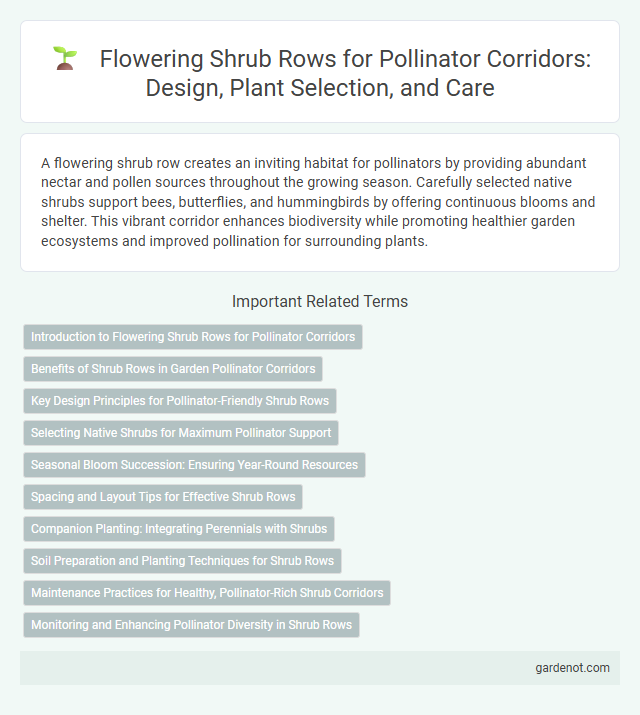A flowering shrub row creates an inviting habitat for pollinators by providing abundant nectar and pollen sources throughout the growing season. Carefully selected native shrubs support bees, butterflies, and hummingbirds by offering continuous blooms and shelter. This vibrant corridor enhances biodiversity while promoting healthier garden ecosystems and improved pollination for surrounding plants.
Introduction to Flowering Shrub Rows for Pollinator Corridors
Flowering shrub rows create vital habitats within pollinator corridors by providing abundant nectar, pollen, and shelter throughout the growing season. Species such as Ceanothus, Viburnum, and Spiraea are particularly effective in attracting diverse pollinators including bees, butterflies, and hummingbirds. Integrating these shrubs improves landscape connectivity, supports pollinator health, and enhances ecosystem resilience.
Benefits of Shrub Rows in Garden Pollinator Corridors
Flowering shrub rows in garden pollinator corridors provide essential nectar and pollen sources that support diverse pollinator species, including bees, butterflies, and hummingbirds. These shrub rows create continuous habitat connectivity, enhancing foraging efficiency and shelter opportunities throughout the pollination season. By stabilizing soil and reducing erosion, flowering shrub rows also contribute to healthier ecosystems and improve biodiversity within urban and rural landscapes.
Key Design Principles for Pollinator-Friendly Shrub Rows
Flowering shrub rows designed for pollinator corridors should prioritize native plant species that bloom sequentially to provide continuous nectar and pollen sources throughout the growing season. Incorporating a mix of shrub heights and densities enhances habitat diversity, offering shelter and foraging opportunities for various pollinator species such as bees, butterflies, and hummingbirds. Site selection with adequate sunlight, soil quality, and minimal pesticide exposure supports robust plant health and optimal pollinator attraction.
Selecting Native Shrubs for Maximum Pollinator Support
Selecting native flowering shrubs such as Ceanothus, Aronia, and Viburnum enhances pollinator corridors by providing essential nectar and pollen sources tailored to local bee, butterfly, and hummingbird species. These shrubs support diverse pollinator populations throughout multiple blooming seasons, ensuring sustained habitat connectivity. Incorporating a variety of native shrubs also promotes ecological resilience and improves overall biodiversity within the corridor.
Seasonal Bloom Succession: Ensuring Year-Round Resources
Flowering shrub rows provide a continuous supply of nectar and pollen by incorporating species with staggered bloom times, supporting pollinators throughout all seasons. Early-blooming shrubs like Forsythia and serviceberry offer vital resources in spring, while summer-blooming species such as butterfly bush and viburnum maintain foraging opportunities. Late-season blossoms from plants like spicebush and beautyberry extend resource availability into fall, fostering pollinator health year-round.
Spacing and Layout Tips for Effective Shrub Rows
Spacing flowering shrub rows at 3 to 5 feet apart ensures optimal air circulation and sunlight penetration, promoting healthy pollinator habitats. Arrange shrubs in staggered patterns to maximize floral resource accessibility and support diverse pollinator species. Maintaining consistent intervals between plants within rows enhances growth uniformity and facilitates maintenance tasks like pruning and weeding.
Companion Planting: Integrating Perennials with Shrubs
Integrating perennials with flowering shrubs in pollinator corridors enhances biodiversity by providing continuous bloom cycles that support a variety of pollinators including bees, butterflies, and hummingbirds. Companion planting with species such as coneflowers, bee balm, and lavender alongside serviceberry or viburnum shrubs creates layered habitats that improve nectar availability and shelter. This strategic plant combination increases ecological resilience and promotes sustainable pollinator populations in urban and rural landscapes.
Soil Preparation and Planting Techniques for Shrub Rows
Effective soil preparation for flowering shrub rows involves deep tilling to improve aeration and drainage, along with incorporating organic compost to enhance nutrient content and microbial activity. Selecting native shrub species adapted to local soil conditions optimizes root establishment and resilience, while planting in staggered rows ensures maximum pollinator access and habitat connectivity. Regular mulching retains soil moisture, suppresses weeds, and supports healthy shrub growth crucial for sustained pollinator corridors.
Maintenance Practices for Healthy, Pollinator-Rich Shrub Corridors
Regular pruning of flowering shrub rows enhances airflow and sunlight penetration, crucial for healthy, pollinator-rich corridors. Implementing seasonal mulching and targeted irrigation supports robust bloom cycles, directly benefiting native bee populations and butterfly activity. Avoiding chemical pesticides preserves vital pollinator habitats, promoting biodiversity within the corridor ecosystem.
Monitoring and Enhancing Pollinator Diversity in Shrub Rows
Monitoring pollinator diversity in flowering shrub rows involves systematic surveys to identify species presence and abundance, providing critical data for conservation efforts. Enhancing pollinator habitats can be achieved by planting diverse native flowering shrubs that bloom sequentially, ensuring continuous nectar and pollen availability. Implementing adaptive management based on monitoring results supports ecosystem resilience and promotes effective pollination services in agricultural and natural landscapes.
Flowering shrub row Infographic

 gardenot.com
gardenot.com